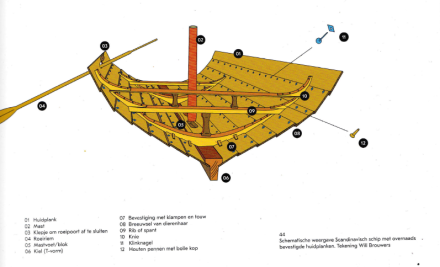Nordic or Scandinavian ship building tradition (keel ships)
In the early and high middle ages, shipping in the north of Europe was largely dominated by a type of ship that we could consider to be part of one building tradition. The most imaginative example is the Viking ship, but many peoples around the North Sea and the Baltic used similar keel ships, and remnants of this building tradition still exist today in Scandinavia.
Origin and construction
The origin of the type probably lies in southern Scandinavia. Keel ships originated there. Early on they were large rowing boats without a sail, which grew out to be the longboats of the Viking era.
The base consisted of a t-shaped keel that formed the backbone of the ship. The lowest hull planks were fastened to cross beams coming from the keel. The other hull planks were applied in a clinker fashion and fastened with rivets.

The frames were fastened to the boards with wooden pens with protruding rounded heads. Below the waterline, the frames were not connected to the boards. This insured a large amount of elasticity and thus heightened the flexibility at sea. The mast was put on an extra beam that was placed on the keel lengthwise.
The seems were waterproofed with caulking consisting of animal hair (cow hair and sheep's wool). There is a clear distinction between light longboats (drakar) that were used for war, and the more robust trading vessels (knar).
Distribution and use
Asides from the famous Vikings, ships of this type were used by many North Sea peoples such as Saxons and Frisians. Ships of this type were built in a large variety of sizes and used for trade, war and fishing. The Scandinavians were the ones who especially made long voyages with them, to the Mediterranean, Russia and to Iceland, Greenland and the north of America. The later medieval cogs basically are a further development of this ship type and we find ships of this type in use in Scandinavia up until today.
Also see: Wij Vikingen : Friezen en Vikingen in het kustgebied van de Lage Landen, W. Brouwers, M. Manders M. Stoter, D. Spiekhout, eds., 2019.